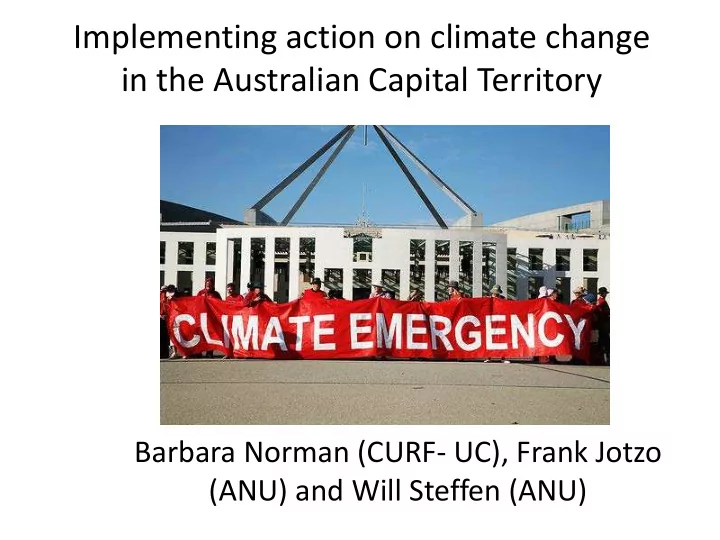

Implementing action on climate change in the Australian Capital Territory Barbara Norman (CURF- UC), Frank Jotzo (ANU) and Will Steffen (ANU)
Canberra…. January 2003
Managing risk IMPACTS SOCIOECONOMIC CLIMATE Vulnerability PROCESSES Socioeconomic Natural Pathways Variability RISK Hazards Adaptation and Mitigation Anthropogenic Actions Climate Change Governance Exposure EMISSIONS and Land-use Change
ACT region climate risks and implications Impacts • Warmer dryer future • More extreme weather events (storms, flash flooding) • More frequent and intense bushfires, drought and extreme heat Consequences • Loss of life and property Reduced quality of life • • Loss of biodiversity & ecosystem services • Changes in regional food production • Expensive responses
Strong targets to cut emissions The Climate Change and Greenhouse Gas Reduction Act 2010 mandates: • 40% below 1990 emission levels by 2020 • 80% below 1990 emissions levels by 2050 • Peaking emissions per capita by 2013 • 90% renewable electricity supply by 2020 Most ambitious targets in Australia
ACT Climate Change Council Left to right: Maria Efkarpidis, Toby Roxburgh, Lynne Harwood, Barbara Norman (Chair), Minister Simon Corbell, Dorte Ekelund, Will Steffen and Frank Jotzo.
Action Plan 2 (AP2) • Released October 2012. • AP2 pathway to 40% of ‘90 levels by 2020. • 18 Actions across key sectors: – Residential, Non-residential, Transport, Waste, Energy supply, Adaptation, Monitoring and reporting. • Three supporting actions: – Carbon Neutral Government Framework, Social Impacts and Cost of Living Review, ACT Greenhouse Gas Inventory Update. • Progress reports are released every six months.
Sustainable Transport Capital Metro Light Rail project Capital Metro is the first stage of light rail for Canberra: 12.5 km link from Gungahlin Town Centre to the CBD Developed along key north- south arterial route $614 million capital project – commence 2016 City building project to bring forward urban consolidation and mixed use development Light Rail Master Plan under development to analyse future route expansion
Improving energy efficiency in commercial buildings Up to 25% remission of lease variation charge where high standards of sustainable design and adaptable housing are nominated in the development application (March 2014 – March 2016). Remissions available: • Commercial (using Green Star ratings) 5 Star = 10%, 6 Star = 25% • Residential (using NatHERS ratings) 6.5 or 7 stars = 10%, 7+ stars = 25% Adaptable housing (complying with Australian standards) • 50% adaptable = 15% ; 100% adaptable = 25%
90% renewables target (490 MW) • Solar Auction 40 MW • Wind energy (1) 200 MW • Community solar 1 MW • Next generation solar 50 MW • Waste from Energy 23 MW • Wind energy (2) ~176 MW = 178,000 homes
Solar Auction Outcomes
• Near term decisions can have long term consequences • Implementation of the ACT Climate Change Strategy across government • Engagement of the community in the process • Uncertainty means ‘learning by doing’ and managing risk
Adapting to a changing climate: directions for the ACT Priority sectors: • Community health and wellbeing • Disaster and emergency management • Settlements and infrastructure • Water • Natural resources and ecosystems • Agriculture
Adapting to a changing climate: Directions for the ACT • Next steps • Identify knowledge gaps • Background papers • Community engagement to identify priorities and pathways • Draft prepared in 2014 • Final Adaptation Strategy end 2015. www.environment.act.gov.au/climate_change/climate-change-adaptation
Community Engagement Strategy Renewed commitment to engage with the community about climate change matters to guide the ACT’s future responses on mitigation and adaptation. Builds on partnerships with households, community organisations, business, knowledge brokers (e.g. Climate Change Council), regional councils and government agencies
Canberra as a national leader • Adapting to change will be both incremental and transformational • Investing in light rail and renewable energy a major step forward CT 16 July 2014 • International interest in the transformation of the national capital and a medium sized city ABC 27 Feb 2014
Conclusions • Climate change is a present and evolving threat to ACT natural systems, communities and our built environment • The ACT, while small, is looking to provide leadership • The ACT’s targets are ambitious but informed by science and they are achievable • Renewable energy is at the heart of the strategy and the solar auction process offers some hope of ensuring continued investment at the lowest cost Acknowledge the contribution by the ACT Environment and Planning Directorate Storm cell rolls into North Canberra on Australia Day 2013 Source: ABC Online
Recommend
More recommend